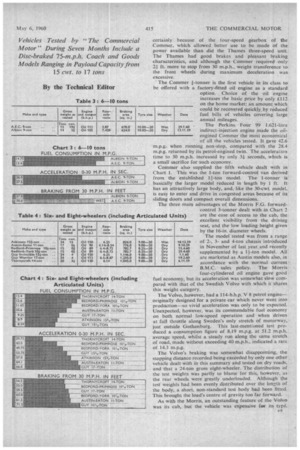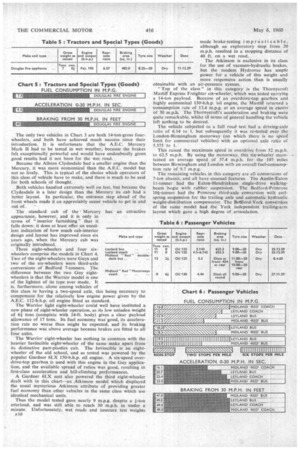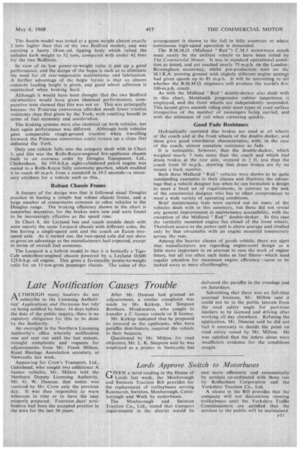TWENTY-ONE TESTS Cover Wide Range
Page 102

Page 103

Page 104

Page 105

If you've noticed an error in this article please click here to report it so we can fix it.
BECAUSE the printing dispute last year delayed publication of the 1959 road-test analysis, the " annual " analysis for this year , covers only seven months. Despite, this, however, 21 vehicles were tested by The Commercial Motor during this period, • albeit two of the models dealt with are merely Slightly . different versions of other basic types and as such vere not given
full, separate reports. _ .
It is usual to find at least one foreign vehicle among those described in these analyses, and this year is no exception. . A Volvo petrol-engined 5-tOnner wilt be found in the second • chart and table, whilst coming into the 5-cwt-2-ton range there is a British-built German-designed 11-ton model.
Although the 'tables covering vehicles of 2-10 tons pay load capacity are rather bare this year, • a comparatively, . large number of vehicles is embodied in • the category of sixand eight-wheelers, including the ThOrnYcroft Mastiff 20-ton-gross six-wheeler—an outstanding . vehicle of its type and up at the top by no mere accident. ,
It is not often that The Commercial Motor gets the chance to road-test vehicles which have been designed and constructed by the undertaking which operates them, but the passenger-vehicle section includes two such examples. These are the " Motorway " 75-m.p.h. coach and the 72-scat integral construction double decker built by the Birmingham and Midland Motor Omnibus Co., Ltd. Both vehicles have such still relatively rare features as rubber suspension and disc brakes in their specifications, and the coach is an outstanding example of safe, high-speed luxury design which, furthermore, shows unexpected fuel economy. . Among the five lightweight vehicles covered by the first table and chart the Jensen-Tempo was exceptional. This German design, powered by a B.M.C. B-series 11-litre petrol engine, proved, when running at just over 21 tons gross weight, to be more economical under all conditions of operation than the two petrolengined 15-cwt. vans tested during the period. Although its acceleration was inferior, the vehicle was lively enough, and had a top speed of over 50 m.p.h.
The Tempo has a tubular backbonetype fraine and independent suspension of all wheels. The engine is located beneath the cab seat, and, for truck bodywork at least, the chassis has a clever design. It is surprising that the vehicle has not proved as popular in this country as in its country of origin.
During the period under review, it was at last possible to publish a road-test report of the Thames . +-ton petrolengined van, built by the Ford Motor Co., Ltd. This model has already sold in large numbers and has the attractions of high maximum speed and good acceleration. On nonstop running it proved to be slightly less economical than the Commer 1-ton petrol-engined van introduced and tested last January, but gained the advantage under simulated delivery operations.
Although the engine in the Cornmer 1-tonner is smaller than that fitted to the Thames, there was little difference in the acceleration times recorded. This was almost "
certainly because of the four-speed gearbox of the Commer, which allowed better use to be made of the power available than did the Thames three-speed unit. The Thames had good brakes and pleasant braking characteristics, and although the Commer required only 2+ ft. more to stop from 30 m.p.h., weight transference to the front wheels during maximum deceleration was excessive.
Weather Date Wet Dry 29.1.60 13.11.59
The Commer .1-tonner is the first vehicle in its class to be offered with a factory-fitted oil engine as a standard option. Choice of the oil engine increases the basic price by only £112 on the home market: an amount which could be recovered quickly by reduced fuel bills of vehicles covering large annual mileages.
The Perkins Four 99 1-.621-litre indirect-injection engine made the oilengined Commer the mot economical of all the vehicles tested. It gave 42.6 m.p.g. when running non-stop, compared with the 28.4 m.p.g. returned by its petrol-engined twin. The acceleration time to 30 m.p.h. increased by only 3+ seconds, which is a small sacrifice for such economy.
Commer also supplied the fifth vehicle dealt with in Chart I. This was the .1-ton forward-control van derived from the established 11-ton model. The1-toriner is basically the larger model reduced in length by 1 ft. Dims an attractively large body, and, like the 30-cwt. model, is easy to enter and drive in congested areas because of its
sliding doors and compact overall dimensions.
The three main advantages of the Morris F.G. forwardcontrol 3-tormer dealt with in Chart 2 are the ease of access to the cab, the excellent visibility from the driving seat, arid the low loading height given by the 16-in, diameter wheels.
The model tested was from a range of 2-, 3and 4-ton chassis introduced in November of last year and recently supplemented by a 11-ton model. All are marketed as Austin models also, in accordance with the normal current B.M.C. sales policy. The Morris four-cylindered oil engine gave good 'fuel economy, but its acceleration was somewhat slow compared with that of the Swedish Volvo with which it shares this weight category.
The Volvo, however, had a 114-b.h.p. V 8 petrol engineoriginally designed for a private car which never went into production-so vivid acceleration was only to be expected. Unexpected, however, was its commendable fuel economy on both normal low-speed operation and when driven at full throttle along Sweden's only stretch of motorway, just outside Gothenburg. This last-mentioned test produced a consumption figure of 8.19 m.p.g. at 51.2 m.p.h. average speed, whilst a steady run along the same stretch of road, made without exceeding 40 m.p.h., indicated a rate of 14.3 m.p.g.
The Volvo's braking was somewhat disappointing, the stopping distance recorded being exceeded by only one other ‘rehicle dealt with in this summary and tested on dry roads, and that a 24-ton gross eight-wheeler. The distribution of the test weights was partly to blame for this, however, as the rear wheels were greatly underloaded. Although the test' weights had been evenly distributed over the length of the body, a short, non-standard test body had been fitted. This brought the load's centre of gravity too far forward.
As with the Morris, an outstanding feature of the Volvo was its cab, but the vehicle was expensive for its type.
Weather Date
Wet 18.12.59 Dry 9.10.59 Dry 15.4.60 Dry 29.4.60 Dry 1.1.60 Dry 19.2.60 Dry 6.11.59
The only two vehicles in Chart 3 are both 14-ton-gross fourwheelers, and both have achieved much success since their introduction. It is unfortunate that the AL C. Mercury Mark II had to be tested in wet weather, because the brakes felt exceptionally powerful and would have undoubtedly given good results had it not been for the wet road.
Because the Albion Clydesdale had a smaller engine than the Mercury, it was more economical than the A.E.C. model but not so lively. This is typical of the choice which operators of this class of vehicle have to make, and there is much to be said for both schools of thought. • • Both vehicles handled extremely well on test, but because the Clydesdale is a later design than the Mercury its cab had 'a better layout. In particular, the entrance step ahead of the front wheels made it an appreciably easier vehicle to get in and out of.
The standard cab of the' Mercury has an attractive appearance, however, and it is only in terms of "interior furnishing" that it falls down: it does at least offer an excellent indication of how much cab-interior design and layout has improved since six years ago, when the Mercury cab was originally introduced.
Three eight-wheelers and four six: wheelers comprise the models in Chart 4.
Two of the eight-wheelers were Guys and two of the six-wheelers were third-axle conversions of Bedford 7-tonners. The difference between the two Guy eightwheelers is that the Warrior model is one of the lightest of its type ever made. It is, furthermore, alone among vehicles of • this class in having a two-speed axle, this being necessary to compensate for the relatively low engine power given by the A.E.C. 112-b.h.p. oil engine fitted as standard. .
The Warrior light eight-wheeler could well have instituted a new phase of eight-wheeler operation, as its low unladen weight of 6* tons (complete with 24-ft. body) gives a clear payload allowance of 17 tons. Its fuel economy was good, its acceleration rate no worse than might be expected, and its braking performance was above average because brakes are fitted to all four axles.
The Warrior eight-wheeler has nothing in common with the heavier Invincible eight-wheeler of•the same make apart from its distinctive part-plastics cab. The Invincible is an eight-. wheeler of the old school, and as tested was powered by the popular Gardner 6LX 150-b.h.p..oil engine. A six-speed overdrive-top gearbox is used with this engine in the Guy application, and the available spread of ratios was good, resulting in first-class acceleration and hill-climbing performances.
A Gardner 6LX unit also powered the third eight-wheeler dealt with in this chart—an Atkinson model which displayed the usual mysterious Atkinson attribute of providing greater fuel economy than other vehicles in the same class which use identical mechanical units.
Thus the model tested gave nearly 9 m.p.g. despite a 3-ton oVerload, and was still able to reach 30 m.p.h. in under a: minute. Unfortunately, wet roads and insecure test weights
Make and type
Leyland bus .. ..
Leyland coach .. ..
Midland " Red " double' deck but .. .. ..
Midland" Red " Motorways coach .. .. .
made brake-testing impracticable, although an exploratory stop from 20 m.p.h. resulted in a stopping distance of 40 ft. on a wet road.
The Atkinson is exclusive in its class for the use of vacuum-hydraulic brakes, but the tandem Hydrovac has ample power for a vehicle of this weight and more responsive action than is usually obtainable with an air-pressure system.
"Top of the class" in this category is the Thbrnycroft Mastiff Express Freighter six-wheeler, -which was tested carrying 8. 14-ton payload. Because of an overdrive-top gearbox and highly economical 130-b.h.p. 'oil engine, the Mastiff returned a tonsurnpticin rate of 11.4 m.p.g. at an average speed in excess of 30 m.p.h.. The Thornycroft's acceleration and braking were quite remarkable, whilst uI terms of general handling the vehicle left nothing to be desired.
The vehicle subjected to a full road test had a driving-axle ratio of 6.14 to 1, but subsequently it was re-tested over the London-Birmingham motorway (on which there is no speed limit for commercial vehicles) with an optional axle ratio of 5.375 to 1.
This raised the maximum speed in overdrive from 52 m.p.h. to 62.5 m.p.h. By using the motorway. this six-wheeler maintained an average speed of 37.4 m.p.h. for the 107 miles between Birmingham and London with an overall fuel-consumption rate of 9.7 m.p.g.
The remaining vehicles in this category are all cdnversions of 7-ton chassis, and all have unusual features. The Austin-Eaton 11-tonner had the Eaton-Hendrickson single-drive walkingbeam bogie with rubber suspension. The Bedford-Primrose 103-tormer had the Primrose third-axle conversion with coilspring suspension for the trailing axle and automatic hydraulic weight-distribution compensator. The Betlford-York conversion of the same model had the York . independent trailing-arm layout which gave a high degree of articulation.
Dry 11.12.59
The Austin model was tested at a gross weight almost exactly 2 tons higher than that of the two Bedford models, and was carrying a heavy 18-cu.-yd. tipping body which raised the unladen kerb weight to 51 tons, compared with under 4* tons for the two Bedfords.
In view of its low power-to-weight ratio, it put up a good performance, and the design of the bogie is such as to eliminate the need for all rear-suspension maintenance and lubrication. A further advantage of the bogie layout is that an almost constant loading height is given, and good wheel adhesion is maintained when braking hard.
Although it would have been thought that the two Bedford six-wheelers would have given identical performances, cornparative tests showed that this was not so. This was principally because the Primrose conversion afforded much lower tractive resistance than that given by the York, with resulting benefit in terms of fuel economy and acceleration.
The braking systems were also identical on both vehicles, but here again performance was different. Although both vehicles gave comparable rough-ground, traction when travelling forward, the Primrose conversion could reverse up a slope that defeated the York.
Only one vehicle falls into the category dealt with in Chart 5, and this was the Rolls-Royce-engined fire-appliance chassis built to an overseas order by Douglas Equipment, Ltd., Cheltenham. Its 195-b.h.p. eight-cylindered petrol engine was mated to a Rolls-Royce fully automatic gearbox, which enabled it to reach 40 m.p.h. from a standstill in 19.5 seconds—a necessary attribute for a vehicle such as this.
Robust Chassis Frame
A feature of the design was that it followed usual Douglas practice in having a simple but robust chassis frame, and a large number of components common to other vehicles in the Douglas range. The braking efficiency shown in the chart is somewhat deceptive, for the brakes were new and were found to be increasingly effective as the speed rose.
In Chart 6, the Leyland bus and coach models dealt with were merely the same Leopard chassis with different axles, the bus having a single-speed unit and the coach an Eaton twospeed axle. As it turned out, the two-speed aide did not show as great an advantage as the manufacturers had expected, except in terms of overall fuel economy.
The Leopard is a hybrid model in that it is basically a Tiger Cub underfloor-engined chassis powered by a Leyland 0.600 125-b.h.p. oil engine. This gives a favourable power-to-weight ratio for an 11-ton-gross passenger chassis. The value of this arrangement is shown to the full in hilly countries or where continuous high-speed operation is demanded.
The B.M.M.O. (Midland " Red ") C.M.5 motorways coach must surely be the swiftest vehicle to have been tested by The Commercial Motor. It was in standard operational condition as tested, and yet reached nearly 75 m.p.h on the LondonBirmingham motorway, whilst pre-production tests on the M.I.R.A. proving ground with slightly different engine settings had given speeds up to 85 m.p.h. It will be interesting to see whether the B.M.M.O. engineers will produce the world's first 100-m.p.h. coach.
As with the Midland "Red" double-decker also dealt with in this chart, Metalastik progressive rubber suspension is employed, and the front wheels are independently suspended. This layout gives smooth riding over most types-of road surface irrespective of the number of passengers being carried, and with the minimum of roll when cornering quickly.
Good Fade Resistance
Hydraulically operated disc brakes are used at all wheels of the coach and at the front wheels of the double-decker, and these gave good retardation characteristics, with, in the case of the coach, almost complete resistance to fade.
It is noticeable, however, that the double-decker. which weighed nearly 5 tons more than the coach and which had drum brakes at the rear axle, stopped in 2 ft. less than the coach from 30 m.p.h., showing that drum brakes are by no means a back number.
Both these Midland "Red" vehicles were shown to be quite outstanding examples in their classes and illustrate the advantage that a vehicle designer has when he can formulate a design to meet a fixed set of requirements, in contrast to the task of the commercial designer who has to effect compromises to meet a wide variety of operating conditions.
Brief maintenance tests were carried out on many of the vehicles dealt with in this summary, but these did not reveal any general improvement in maintenance accessibility, with the exception of the Midland " Red" double-decker. In this case the vertically mounted engine lies ahead of the front wheels. Therefore access to the power unit is above average and rivalled only by that obtainable with an engine mount&I transversely across the rear.
Among the heavier classes of goods vehicle, there are signs that manufacturers are regarding engine-cowl design as a little more important in an attempt to ease the work of engine fitters, but all too often such items as fuel filters—which need regular attention for maximum engine efficiency—seemto be tucked away as mere afterthoughts.




































































































































































































































































